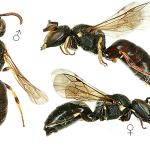Hylaeus annularis auct.
Previously known as Hylaeus annularis (Kirby, 1802) - see recent name changes. British representatives of the subgenus Lambdopsis are restricted to Hylaeus dilatatus and H. annularis (formerly H. spilotus).The females of both differ from other British Hylaeus in the reduced, circular (not wedge-shaped or linear) paraocular markings; the males have greatly dilated, yellow and black-marked, sub-rectangular antennal scapes (easily visible to the naked eye).
Widely distributed, though local, in southern England; the range extends north to the Midlands (Leicestershire). In Wales, only recorded from South Glamorgan (Hallett 1927). There are no records from Scotland, Ireland or the Channel Islands. The species is found throughout Europe and east to Anatolia and the Caucasus (Koster 1986).
The bee is not regarded as scarce or being threatened.
The species is often locally common on calcareous grassland, but has been reported from coastal sites, fens and open woodland.
Univoltine; early June to late August or early September. As with all British Hylaeus, the females are often long lived (the males having a considerably shorter adult life).
The species has been reared on several occasions from burrows in dead bramble and rose stems in which the pith has been exposed (pers. obs.). There are additional records from other dead stems such as dock and mugwort (Smith 1876; Peeters, Raemakers, & Smit 1999, respectively). O W Richards (1930) observed the bee nesting in burrows in rotten fence posts.
Bramble (Rubus fruticosus agg.), cinquefoil (Potentilla sp.), common fleabane (Pulicaria dysenterica), creeping thistle (Cirsium arvense), field bindweed (Convolvulus arvensis), hogweed (Heracleum sphondylium), pale toadflax (Linaria repens), sea spurge (Euphorbia paralias), wild carrot (Daucus carota) and yarrow (Achillea millefolium).
The gasteruptiid wasp Gasteruption assectator has been reared from nests of H. dilatatus in mainland Europe (Höpper 1904) and may parasitise this species in Britain.
2013


